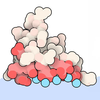[English] 日本語
 Yorodumi
Yorodumi- PDB-1ghy: A NOVEL SERINE PROTEASE INHIBITION MOTIF INVOLVING A MULTI-CENTER... -
+ Open data
Open data
- Basic information
Basic information
| Entry | Database: PDB / ID: 1ghy | |||||||||
|---|---|---|---|---|---|---|---|---|---|---|
| Title | A NOVEL SERINE PROTEASE INHIBITION MOTIF INVOLVING A MULTI-CENTERED SHORT HYDROGEN BONDING NETWORK AT THE ACTIVE SITE | |||||||||
 Components Components |
| |||||||||
 Keywords Keywords | HYDROLASE/HYDROLASE INHIBITOR / three-centered / very short hydrogen bond / oxyanion hole water / shift of pKa of His57 / structure-based drug design / specificity / urokinase / trypsin / thrombin / Zn+2-mediated inhibition / BLOOD CLOTTING / HYDROLASE-HYDROLASE INHIBITOR COMPLEX | |||||||||
| Function / homology |  Function and homology information Function and homology informationcytolysis by host of symbiont cells / thrombospondin receptor activity / thrombin-activated receptor signaling pathway / Defective factor XII causes hereditary angioedema / thrombin / negative regulation of astrocyte differentiation / regulation of blood coagulation / positive regulation of phospholipase C-activating G protein-coupled receptor signaling pathway / neutrophil-mediated killing of gram-negative bacterium / Defective F8 cleavage by thrombin ...cytolysis by host of symbiont cells / thrombospondin receptor activity / thrombin-activated receptor signaling pathway / Defective factor XII causes hereditary angioedema / thrombin / negative regulation of astrocyte differentiation / regulation of blood coagulation / positive regulation of phospholipase C-activating G protein-coupled receptor signaling pathway / neutrophil-mediated killing of gram-negative bacterium / Defective F8 cleavage by thrombin / Platelet Aggregation (Plug Formation) / ligand-gated ion channel signaling pathway / positive regulation of collagen biosynthetic process / negative regulation of platelet activation / negative regulation of blood coagulation / positive regulation of blood coagulation / negative regulation of fibrinolysis / regulation of cytosolic calcium ion concentration / Transport of gamma-carboxylated protein precursors from the endoplasmic reticulum to the Golgi apparatus / Gamma-carboxylation of protein precursors / Common Pathway of Fibrin Clot Formation / Removal of aminoterminal propeptides from gamma-carboxylated proteins / fibrinolysis / Intrinsic Pathway of Fibrin Clot Formation / negative regulation of proteolysis / negative regulation of cytokine production involved in inflammatory response / positive regulation of release of sequestered calcium ion into cytosol / Peptide ligand-binding receptors / Regulation of Complement cascade / acute-phase response / Cell surface interactions at the vascular wall / positive regulation of receptor signaling pathway via JAK-STAT / lipopolysaccharide binding / growth factor activity / serine-type endopeptidase inhibitor activity / positive regulation of insulin secretion / platelet activation / response to wounding / Golgi lumen / positive regulation of protein localization to nucleus / Regulation of Insulin-like Growth Factor (IGF) transport and uptake by Insulin-like Growth Factor Binding Proteins (IGFBPs) / positive regulation of reactive oxygen species metabolic process / blood coagulation / antimicrobial humoral immune response mediated by antimicrobial peptide / regulation of cell shape / heparin binding / Thrombin signalling through proteinase activated receptors (PARs) / : / positive regulation of cell growth / blood microparticle / G alpha (q) signalling events / cell surface receptor signaling pathway / positive regulation of phosphatidylinositol 3-kinase/protein kinase B signal transduction / receptor ligand activity / endoplasmic reticulum lumen / signaling receptor binding / serine-type endopeptidase activity / positive regulation of cell population proliferation / calcium ion binding / proteolysis / extracellular space / extracellular exosome / extracellular region / plasma membrane Similarity search - Function | |||||||||
| Biological species |  Homo sapiens (human) Homo sapiens (human) Hirudo medicinalis (medicinal leech) Hirudo medicinalis (medicinal leech) | |||||||||
| Method |  X-RAY DIFFRACTION / Resolution: 1.85 Å X-RAY DIFFRACTION / Resolution: 1.85 Å | |||||||||
 Authors Authors | Katz, B.A. / Elrod, K. / Luong, C. / Rice, M. / Mackman, R.L. / Sprengeler, P.A. / Spencer, J. / Hatayte, J. / Janc, J. / Link, J. ...Katz, B.A. / Elrod, K. / Luong, C. / Rice, M. / Mackman, R.L. / Sprengeler, P.A. / Spencer, J. / Hatayte, J. / Janc, J. / Link, J. / Litvak, J. / Rai, R. / Rice, K. / Sideris, S. / Verner, E. / Young, W. | |||||||||
 Citation Citation |  Journal: J.Mol.Biol. / Year: 2001 Journal: J.Mol.Biol. / Year: 2001Title: A novel serine protease inhibition motif involving a multi-centered short hydrogen bonding network at the active site. Authors: Katz, B.A. / Elrod, K. / Luong, C. / Rice, M.J. / Mackman, R.L. / Sprengeler, P.A. / Spencer, J. / Hataye, J. / Janc, J. / Link, J. / Litvak, J. / Rai, R. / Rice, K. / Sideris, S. / Verner, E. / Young, W. | |||||||||
| History |
|
- Structure visualization
Structure visualization
| Structure viewer | Molecule:  Molmil Molmil Jmol/JSmol Jmol/JSmol |
|---|
- Downloads & links
Downloads & links
- Download
Download
| PDBx/mmCIF format |  1ghy.cif.gz 1ghy.cif.gz | 158.1 KB | Display |  PDBx/mmCIF format PDBx/mmCIF format |
|---|---|---|---|---|
| PDB format |  pdb1ghy.ent.gz pdb1ghy.ent.gz | 125.5 KB | Display |  PDB format PDB format |
| PDBx/mmJSON format |  1ghy.json.gz 1ghy.json.gz | Tree view |  PDBx/mmJSON format PDBx/mmJSON format | |
| Others |  Other downloads Other downloads |
-Validation report
| Summary document |  1ghy_validation.pdf.gz 1ghy_validation.pdf.gz | 690.9 KB | Display |  wwPDB validaton report wwPDB validaton report |
|---|---|---|---|---|
| Full document |  1ghy_full_validation.pdf.gz 1ghy_full_validation.pdf.gz | 695.8 KB | Display | |
| Data in XML |  1ghy_validation.xml.gz 1ghy_validation.xml.gz | 21.8 KB | Display | |
| Data in CIF |  1ghy_validation.cif.gz 1ghy_validation.cif.gz | 30.4 KB | Display | |
| Arichive directory |  https://data.pdbj.org/pub/pdb/validation_reports/gh/1ghy https://data.pdbj.org/pub/pdb/validation_reports/gh/1ghy ftp://data.pdbj.org/pub/pdb/validation_reports/gh/1ghy ftp://data.pdbj.org/pub/pdb/validation_reports/gh/1ghy | HTTPS FTP |
-Related structure data
| Related structure data |  1ghvC  1ghwC  1ghxC 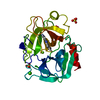 1ghzC 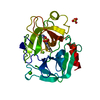 1gi0C  1gi1C  1gi2C 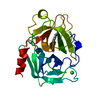 1gi3C 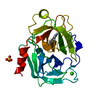 1gi4C  1gi5C 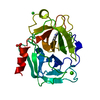 1gi6C  1gi7C  1gi8C  1gi9C C: citing same article ( |
|---|---|
| Similar structure data |
- Links
Links
- Assembly
Assembly
| Deposited unit | 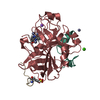
| |||||||||
|---|---|---|---|---|---|---|---|---|---|---|
| 1 |
| |||||||||
| 2 | 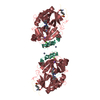
| |||||||||
| Unit cell |
| |||||||||
| Components on special symmetry positions |
|
- Components
Components
-Protein/peptide , 2 types, 2 molecules LI
| #1: Protein/peptide | Mass: 4096.534 Da / Num. of mol.: 1 / Fragment: LIGHT CHAIN, RESIDUES 328-363 / Source method: isolated from a natural source / Source: (natural)  Homo sapiens (human) / References: UniProt: P00734, thrombin Homo sapiens (human) / References: UniProt: P00734, thrombin |
|---|---|
| #3: Protein/peptide | Mass: 1491.528 Da / Num. of mol.: 1 / Source method: obtained synthetically / Source: (synth.)  Hirudo medicinalis (medicinal leech) / References: UniProt: P28504 Hirudo medicinalis (medicinal leech) / References: UniProt: P28504 |
-Protein , 1 types, 1 molecules H
| #2: Protein | Mass: 29594.055 Da / Num. of mol.: 1 / Fragment: HEAVY CHAIN, RESIDUES 364-620 / Source method: isolated from a natural source / Source: (natural)  Homo sapiens (human) / References: UniProt: P00734, thrombin Homo sapiens (human) / References: UniProt: P00734, thrombin |
|---|
-Non-polymers , 5 types, 371 molecules 


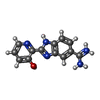





| #4: Chemical | | #5: Chemical | ChemComp-NA / | #6: Chemical | ChemComp-CA / | #7: Chemical | ChemComp-121 / | #8: Water | ChemComp-HOH / | |
|---|
-Details
| Has protein modification | Y |
|---|
-Experimental details
-Experiment
| Experiment | Method:  X-RAY DIFFRACTION / Number of used crystals: 1 X-RAY DIFFRACTION / Number of used crystals: 1 |
|---|
- Sample preparation
Sample preparation
| Crystal | Density Matthews: 2.63 Å3/Da / Density % sol: 53.29 % | |||||||||||||||||||||||||||||||||||
|---|---|---|---|---|---|---|---|---|---|---|---|---|---|---|---|---|---|---|---|---|---|---|---|---|---|---|---|---|---|---|---|---|---|---|---|---|
| Crystal grow | Temperature: 298 K / Method: vapor diffusion / pH: 8.2 Details: PEG 4000, NaCl, pH 8.2, vapor diffusion, temperature 298K | |||||||||||||||||||||||||||||||||||
| Crystal grow | *PLUS Method: vapor diffusion, hanging drop / PH range low: 8.2 / PH range high: 7.5 | |||||||||||||||||||||||||||||||||||
| Components of the solutions | *PLUS
|
-Data collection
| Diffraction | Mean temperature: 298 K |
|---|---|
| Diffraction source | Source:  ROTATING ANODE / Type: RIGAKU RU200 / Wavelength: 1.5418 ROTATING ANODE / Type: RIGAKU RU200 / Wavelength: 1.5418 |
| Detector | Type: SIEMENS / Detector: AREA DETECTOR / Date: 1996 |
| Radiation | Protocol: SINGLE WAVELENGTH / Monochromatic (M) / Laue (L): M / Scattering type: x-ray |
| Radiation wavelength | Wavelength: 1.5418 Å / Relative weight: 1 |
| Reflection | Resolution: 1.8→50.48 Å / Num. all: 34241 / Num. obs: 23179 / % possible obs: 67.3 % / Observed criterion σ(I): 1 / Redundancy: 2.1 % / Rmerge(I) obs: 0.085 / Net I/σ(I): 10.1 |
| Reflection shell | Resolution: 1.85→1.93 Å / Num. unique all: 1539 / % possible all: 40.6 |
| Reflection | *PLUS Num. obs: 23058 / Redundancy: 2.5 % / Num. measured all: 57645 / Rmerge(I) obs: 0.075 |
- Processing
Processing
| Software |
| |||||||||||||||||||||
|---|---|---|---|---|---|---|---|---|---|---|---|---|---|---|---|---|---|---|---|---|---|---|
| Refinement | Resolution: 1.85→7 Å / σ(F): 1.75 / Stereochemistry target values: X-PLOR force field Details: Met_H106, Val_H157, and Met_H210 were simultaneously refined in two conformations. No density was observed for Trp148, Thr149, Ala149A, Asn149B, Val149C, Gly149D, and Lys149E in the ...Details: Met_H106, Val_H157, and Met_H210 were simultaneously refined in two conformations. No density was observed for Trp148, Thr149, Ala149A, Asn149B, Val149C, Gly149D, and Lys149E in the autolysis loop, and these residues are not included in the model. No density was observed for C-terminal residues of the heavy chain following Phe_H245. Residues after Phe_H245 are not included in the model. Disordered waters include: HOH394 which is in a special position. (It is close to a symmetry related equivalent of itself); HOH395 is close to a symmetry related equivalent of itself; HOH396 is close to a symmetry related equivalent of itself; HOH397 is close to a symmetry related equivalent of itself. The above "waters" correspond to density that is more electron dense than waters. The occupancies were allowed to refine to values greater than unity. HOH452 which is close to HOH453; HOH691 which is close to HOH693, which in turn is close to HOH692. HOH817 which is close to a symmetry-related equivalent of itself; HOH1355 which is too close to Oe2 of of Glu_L14H HOH1358 which is close to HOH1359; HOH1368 which is close to a symmetry-related equivalent of itself; HIS_H57 IS mono-protonated on the delta nitrogen. HIS_H91 and His_H119 are MONOPROTONATED ON the epsilon nitrogen
| |||||||||||||||||||||
| Refinement step | Cycle: LAST / Resolution: 1.85→7 Å
| |||||||||||||||||||||
| Refine LS restraints |
| |||||||||||||||||||||
| Software | *PLUS Name:  X-PLOR / Version: 3.851 / Classification: refinement X-PLOR / Version: 3.851 / Classification: refinement | |||||||||||||||||||||
| Refinement | *PLUS Lowest resolution: 7 Å / σ(F): 1.75 / Rfactor all: 0.196 / Rfactor obs: 0.195 / Rfactor Rfree: 0.22 | |||||||||||||||||||||
| Solvent computation | *PLUS | |||||||||||||||||||||
| Displacement parameters | *PLUS | |||||||||||||||||||||
| Refine LS restraints | *PLUS
| |||||||||||||||||||||
| LS refinement shell | *PLUS Highest resolution: 1.85 Å / Lowest resolution: 1.93 Å / Rfactor Rfree: 0.22 / Rfactor obs: 0.196 |
 Movie
Movie Controller
Controller


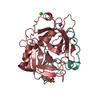
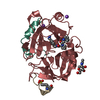
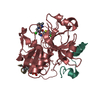
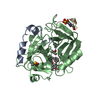
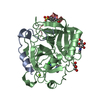

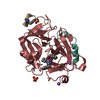
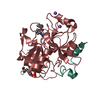
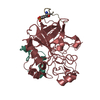
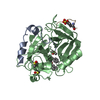

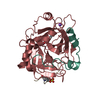

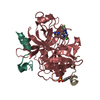
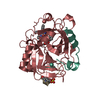
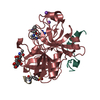


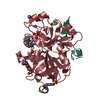

 PDBj
PDBj



